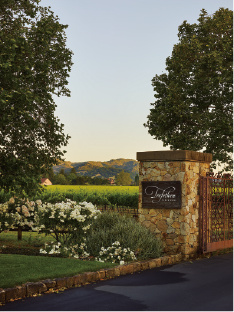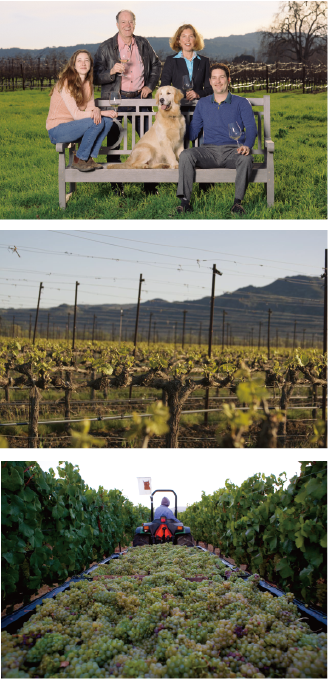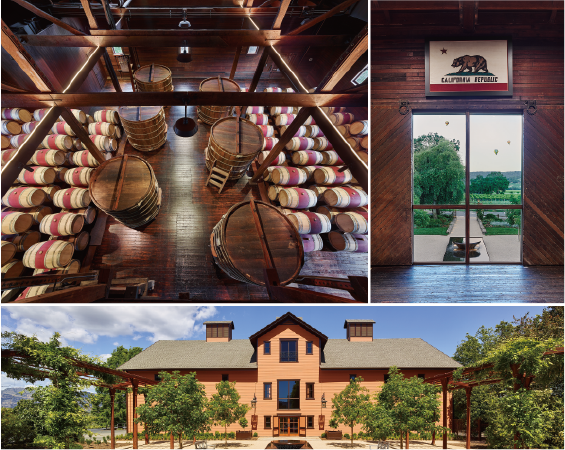
Our Story
It was never clear how this adventure was going to turn out. In the late 60’s, when my family started to grow wine grapes in Napa Valley, there was no one to show them the way. There was plenty of advice, to be sure, but in truth, no one had started a successful Napa vineyard since Prohibition. They were, in a word, crazy.
Their lunacy was infectious, however, and a few other enterprising souls joined the gambit: Tony Baldini, our first viticulturist; David Whitehouse, our first “real” winemaker; Richard DeGarmo, Mr. fix-it; Mary Ware, queen of the office and everyone’s schedule. I grew up with them and consider them all family. A shared passion brought them to us, and my parents received them with open arms. They settled into their respective posts, not as hired hands, but as equals in a shared endeavor. As I settle into my own role in the family business, I find this remarkable dynamic preserved and count myself blessed to spend my days working with old and new friends that quickly feel like family.
The land focuses our energies, as it always has, challenging us to understand its soils, the vines that grow in them, and the way fog drifts through the rows in the morning. It is an eternal learning process – each question answered reveals another be asked – but it’s a journey we love to take with each and every vintage. It also defines us and the wines we make, providing the vital essence of every bottle that bears our name. Decisions made in the vineyard and cellar not only guide the expression of the land, but affect the very soul of the wine. For this reason, we have always committed ourselves to estate production, adamant that we should be the ones growing the grapes and turning them into wine. Our passion requires it.
One Family. One Estate. One Passion. This is who we are.
__________________________________ Loren Trefethen
The Trefethens
During his decades as a key executive for Kaiser Industries, where he helped construct the San Francisco-Oakland Bay Bridge and the Hoover and Shasta dams, Eugene Trefethen and his wife Catherine entertained frequently, with scotch the socially mandated beverage of choice. But at family and business dinners, Catherine, a gifted chef and gardener, made sure the table was laden with good food – including fresh vegetables from her garden – and fine wine. When Gene retired in 1968, the wine-loving Trefethens moved to Napa Valley – then considered an agricultural backwater – where they purchased six small farms and the ramshackle 19th-century Eschol Winery, creating a 600-acre wine estate. At the time, there were fewer than 20 operational wineries in Napa Valley and many of its vineyards were on life support. Where others saw ruin, however, the visionary Trefethens saw enormous potential.
The couple’s intention was to sell all their grapes, but their son John had other ideas. While studying at Stanford University’s Graduate School of Business, John began making small batches of wine in the basement of his parents’ Napa home. (John’s original foray into fermentation, a batch of apple cider, went explosively awry in a friend’s dorm room, one of many teenage escapades that earned him an enduring reputation as a mischief-maker.) His initial efforts, using trash cans as fermentation tanks, were unpromising. Yet, in 1973, aided by his new bride Janet, John produced Trefethen Vineyards’ first commercial wine. Just three years later, the winery’s 1976 Chardonnay earned “Best Chardonnay in the World” honors at the 1979 Gault Millau World Wine Olympics in Paris. That accomplishment, coupled with John’s good business sense and determination to create a world-class wine estate, put Trefethen Vineyards on the global fine wine map.

Today, John devotes himself full-time to the family winery, inspiring the Trefethen team with his jocularity and still-youthful energy. A talented race car driver, he often spends weekends at the track lapping drivers half his age. As Trefethen came to prominence during the 1970s, Janet Trefethen took responsibility for the winery’s marketing efforts, becoming one of the wine industry’s first female executives. Having grown up on a Northern California rice farm, Janet knew agriculture and was an accomplished horsewoman, yet she was initially greeted with derision in the heavily male-dominated world of wine. Her savvy and sparkling personality, however, soon won hearts and minds throughout the industry, establishing her as one of California’s most engaging wine personalities. Along with Catherine Trefethen and several other female vintners, Janet also pioneered the promotion of wine with food, creating the groundbreaking Napa Valley Cooking Class in 1973.
Janet still works later at the winery than anyone – among other things, she designs every Trefethen wine label – yet she still finds time to cook dinner for her family and exercise her beloved cutting horses. Among the nation’s top female cutting horse riders, she’s earned a rare belt buckle from the Cowgirl Hall of Fame and was among the top five-ranked riders in the world in 2005.
John and Janet’s children, Loren and Hailey, now work (voluntarily!) at the winery full-time. Having literally grown up in the middle of the family vineyard, the siblings have traveled widely with their parents throughout the world’s leading wine regions. A graduate of Stanford University, Loren joined the winery in 2007 and has spent several summers immersed in vineyard and cellar operations, including a memorable harvest at famed Chateau Petrus in Bordeaux. He also is injecting new energy and ideas into the marketing and sales departments, with a focus on promoting direct and export sales of Trefethen wines. Hailey, who graduated from Santa Clara University in 2008 with a degree in Biological Anthropology, helped her parents chair the 2009 Napa Valley Wine Auction and wears a variety of hats, from marketing to production, even beekeeper of the estates bee hives. She currently works in viticulture & winemaking operations.
Hailey and Loren are often found together hatching schemes to make life at Trefethen even more exciting. Just as John and Janet took the reins from Eugene and Catherine in the 1970s, Loren and Hailey are poised to put their generation’s stamp on the Trefethen credo of “One Family, One Estate, One Passion.”
The Winemaking Team
Wine is a shared passion at Trefethen. Our wines are made not by a single individual, but by a cohesive team of passionate winemakers and viticulturists dedicated to crafting the finest wines possible from our cherished Napa Valley estate vineyard.
Jon Ruel, Chief Executive Officer
Jon Ruel, Chief Executive Officer Since his arrival at Trefethen in 2004, Jon has played a key role in furthering our mission of making world- class wines that fully capture our estate vineyard’s unique terroir. Hired initially as our viticulturist, Jon quickly made small changes that had huge, beneficial effects on wine quality. Taking a horticultural approach to grape-growing, he insists tha each sub-block, row and vine in our vineyard receives the attention it needs when it needs it, keeping our vineyard crew constantly on the move.
With an approach blending ancient methods with modern technology, Jon now guides the entire process of crafting our wines from vineyard to bottle. He does so with a keen environmental awareness derived from his scientific background, which includes an M.S. degree in Viticulture and Enology from the University of California at Davis, an M.S. degree in Ecology, and over 10 years of ecological research spanning the globe from Antarctica to the Norwegian Arctic.
Jon served as President of the Board of Directors of the Napa Valley Grapegrowers and as a member of the advisory council of the Bay Area Air Quality Management District, a regional agency entrusted with regulating air quality across all nine counties of the San Francisco Bay Area. He speaks frequently at wine industry events, where he often details Trefethen’s extensive sustainability programs, including La Huerta, the five-acre fruit and vegetable garden Jon created on our estate to provide free, delicious organic produce to our employees.
Bryan Kays, Winemaker
With an approach blending ancient methods with modern technology, Jon now guides the entire process of crafting our wines from vineyard to bottle. He does so with a keen environmental awareness derived from his scientific background, which includes an M.S. degree in Viticulture and Enology from the University of California at Davis, an M.S. degree in Ecology, and over 10 years of ecological research spanning the globe from Antarctica to the Norwegian Arctic.
Dan Blakely, Assistant Winemaker
Dan earned degrees in mathematics and economics from Syracuse University. Following graduation, a nine month stint working in finance in Manhattan was more than ample time for Dan to realize he wanted to be doing something different. His passion for wine lead him to UC Davis, where he obtained a degree in Viticulture and Enology. Dan’s prior experience includes working at Schramsberg; and Red Tail Ridge in the Finger Lakes region of New York. Similar to other members of the production team, Dan’s first experience at Trefethen came in the form of a harvest internship in 2011. Dan jumped at the opportunity to return full time as Enologist in 2013, and he was promoted to Assistant Winemaker in 2015.
Brendan Brambila, Director of Viticulture Brendan’s passion for viticulture
Brendan’s passion for viticulture began long before he joined Trefethen in 2009. The son of a Napa Valley winemaker, he was immersed in the wine business at a young age. In 2006, Brendan graduated from Cal Poly, San Luis Obispo sporting a degree in Agricultural Business, with an emphasis on wine and viticulture. He has worked in vineyards throughout Napa Valley and the Russian River Valley in Sonoma County and understands how terroir–the sum total of all the environmental factors affecting a vineyard–plays a crucial role in the crafting of world-class wines. Brendan has a deep appreciation of the unique growing conditions that allow multiple varieties to thrive in our estate vineyard, and he is dedicated to optimizing their quality and distinctive character.
The Main Ranch
As one of Napa Valley’s few remaining family wine estates, Trefethen Vineyards has never purchased a single outside grape. Located in the Oak Knoll District of Napa Valley, our estate vineyard is nestled in a verdant landscape of vines at the cooler, southern end of Napa Valley.
During the 1980s, a root louse known as phylloxera, which had devastated Northern California vineyards a century earlier, re-emerged and began a rapid decimation of the world-renowned vineyards of Napa and Sonoma counties.
As a result, we planted over 10,000 new vines, utilizing the experience we’d gained over the previous 20 years and implementing many of the successful vineyard experiments we had conducted during that time. In truth, phylloxera provided an opportunity to re-assess what we had originally planted and where. Aided by winemakers David Whitehouse Jr. and Peter Luthi, we carefully researched which varietals, rootstocks and clones to plant in the different sections of our revitalized vineyard, initiating a costly ten-year project that by the first years of the 21st century had both literally and figuratively borne fruit.
Director of Viticulture Jon Ruel has spearheaded a further revolution in the vineyard. Thinking more like a horticulturist, Jon has segmented the vineyard into five dozen different ‘gardens’ delineated by variety, soil type, trellising system and irrigation regimen. Jon and his crew lavish extreme attention on each block, extrapolating ideal pruning, shoot positioning, leaf removal, cluster thinning and irrigation practices from the needs of each vine.
As a result, Trefethen now farms 63 distinct vineyard blocks, encompassing nine different grape varieties (Chardonnay, Cabernet Sauvignon, Merlot, Riesling, Pinot Noir, Cabernet Franc, Malbec, Petit Verdot, and Viognier), 10 different types of rootstock, and 49 different clones (genetic variations of a grape variety), including 13 of Chardonnay and 10 of Cabernet Sauvignon. This degree of specialization and intense focus on individual blocks maximizes the potential of each of our varieties and creates the foundation for producing consistently superb, world-class wines.

Constructed in 1886 by a Scottish sea captain, Hamden McIntyre, our winery was originally known as Eshcol. McIntyre designed it as a gravity-flow system: a horse-drawn winch brought grapes to the third floor of the three-story structure for crushing; gravity carried the juice to the second floor fo fermenting; and, eventually, the wine descended to the first floor for aging. Eshcol was among a number of wineries McIntyre designed during this period; the others were Greystone (now The Culinary Institute of America), Far Niente and Inglenook.
During the last quarter of the nineteenth century, Napa Valley was a thriving viticultural community with nearly 140 wineries. However, in the late 1890s, phylloxera, a root louse that destroys grapevines, brought wine production in Napa to a crashing halt. Growers soon recovered with re- planted vines, but in 1920, Prohibition arrived, driving a stake through the heart of the wine business. The old Eshcol facility survived by making sacramental wines, but by 1940 was dormant. When the Trefethen family purchased the property in 1968, the winery had fallen into serious disrepair. John and Janet committed themselves to restoring the building to its former glory.
They carefully researched the winery’s past and worked for years to restore it. Aside from replacing the dirt floor on the first level with concrete, they made no significant structural changes. The Trefethens’ restoration efforts were recognized in 1988 by the Department of the Interior, which placed the winery on the National Register of Historic Places as the only 19th-century, wooden, gravity-flow winery surviving in Napa County.
Today, Trefethen boasts a state-of-the-art fermentation facility and 13,000 square foot barrel cellar, but the McIntyre Building remains integral to the winery’s operations. The first floor is still used to age wine and also houses the winery’s Estate Tasting Room and Wine Library. The second floor, which displays the Eshcol winery’s original de-stemmer/crusher, is a barrel-aging cellar for the winery’s Bordeaux variety red wines.
Our Sustainability Program
Our passion extends beyond the wines themselves to the place we live and work. Our family is strongly committed to being good stewards of the land, responsible neighbors and enlightened employers. To make great wine, you have to have great grapes. We firmly believe that the only way to do this is by keeping our vineyards healthy and thriving, which is why we practice sustainable farming.
Our practices include:
- We have three solar arrays to fully cover our demand for electricity
- Employing our vineyard workers year-round, providing them with living wages and comprehensive benefits
- Recycling all winery wastewater to irrigate our vineyards
- Using sustainable methods to remove weeds and prevent mildew
- Employing deficit irrigation techniques to curtail our water usage
- Recycling all pomace (skins, seeds, stems) to use as compost in our vineyards
- Harvesting in early morning rather than using power to cool the juice mechanically
- Practicing natural pest control – e.g., barn owl and bat boxes
- Restoring riparian areas to maintain and enhance aquatic and wildlife habitats

During the past three decades, Trefethen wines have amassed a cornucopia of major awards and accolades, beginning in 1979, when our 1976 Chardonnay – just our fourth vintage! – was chosen “Best Chardonnay” in the world at the Gault-Millau World Wine Olympics in Paris.
Many more such honors have followed, including our 1997 Reserve Cabernet Sauvignon being named “Best Red Wine in America” at the Atlanta International Wine Challenge and our flagship 2005 HaLo Cabernet Sauvignon being selected as one of the “Top Ten Wines” of 2009 by Connoisseurs’ Guide to California Wines. Below is a small sampling of the plaudits our wines have earned over the years.
